Njamito Goes Fairtrade for Cocoa and Vanilla
March 31, 2025Njamito is now Fairtrade certified for cocoa and vanilla! Here’s what that means for farmers, the planet, and the values behind our meal-in-a-bottle.
Read articleWhat if we told you that sunflower seeds you buy were sprayed with 9 active ingredients in pesticides? What if we told you this wouldn't have been necessary?
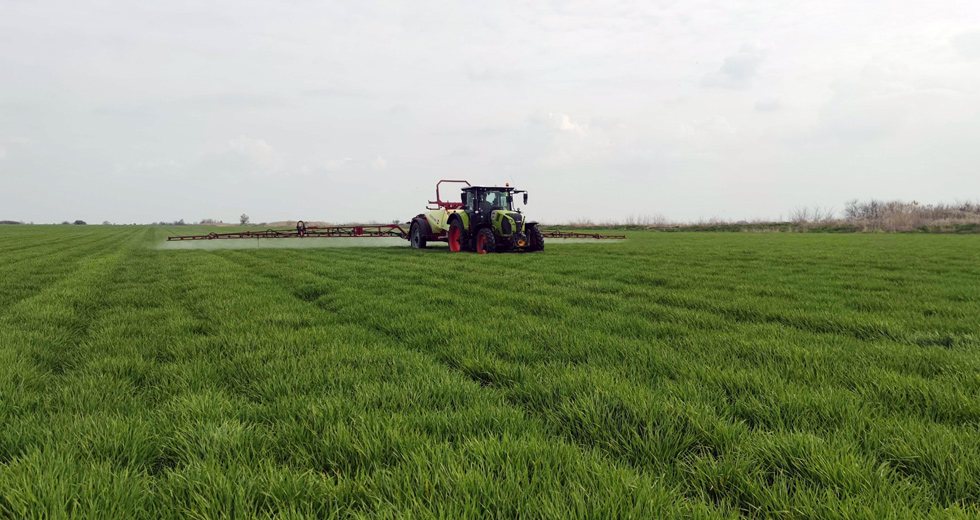
What if we told you that the sunflower seeds you buy in a supermarket grew being sprayed with 9 different active ingredients contained in pesticides? Applying this scenario on 658 hectares of land, this would mean 16,5 tonnes of synthetic pesticides in a year, or almost 50 tonnes over the course of three years.
Now… What if we told you that this wouldn’t have been necessary?
Do we have your attention now?
People have been figuring out ways to protect plants throughout history. Of course, no one wants their hard work on the fields to be damaged by insects or diseases, weakening their crops and decimating their yields. From the first recorded use of sulfur to control insects and mites in Mesopotamia to nicotine sulfate from tobacco used in Renaissance Europe, civilizations have been on a constant search for the most effective method that could protect their crops.
But it wasn’t until the industrial revolution and discovery of synthetic chemicals in the 1800s and the subsequent chemical pesticides boom after World War II that people seriously started to damage planetary health in the name of what became known as “plant protection” but has shown to be detrimental for human health and the environment in the name of profit.
“How can anyone sleep easily knowing that short-term gains with synthetic inputs create long-term damage to people and the environment.”
With the development of intensive farming, pesticides improved efficiency in managing pests and diseases, and guaranteed yield stability. But now we know that those same preparations are toxic, can lead to chronic effects on health like cancer, endocrine disruption, and neurological disorders, and cause birth defects and developmental issues in children. These are coupled with the negative effects of synthetic pesticides on the environment – from biodiversity loss, to soil degradation, development of resistant pests, bioaccumulation and overall ecosystem disruption.
And so we decided to look at the amount of plant protection products conventional farmers generally use to protect plants in intensive agriculture, without fully realizing how much damage they constantly incur on the environment.
We know that individual conventional farmers have different approaches to plant protection. For the purposes of this article we chose one of their options.
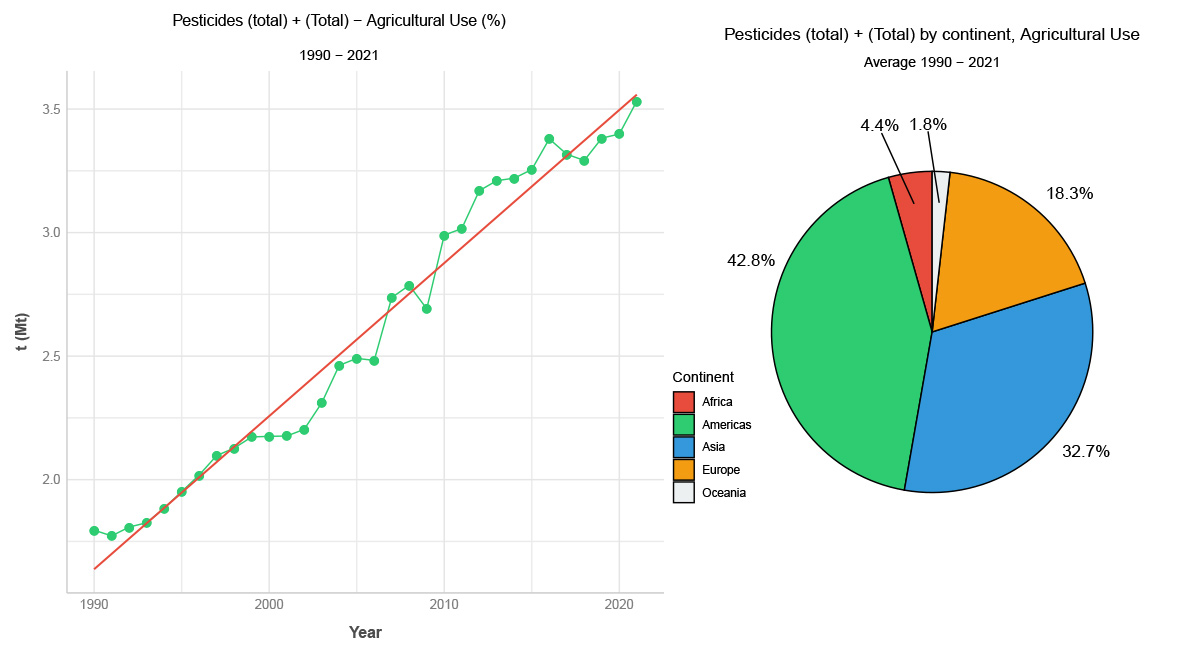
Looking at Serbia – home to our LoginEKO farm – we found that in a year, companies import on average almost 7,000 tonnes of pesticides.
This immense tonnage is destined to be sprayed over a total of 3,257,100 hectares of agricultural land in the country.
In fact it is sprayed over at least 3,700 hectares less than total agricultural land in Serbia. And that’s because at LoginEKO farm, we don’t use any synthetic pesticides.
At our farm, we are all about sustainable methods. In fact, we are proving that large-scale farming without synthetic and animal inputs works.
Let us show you what we would have been doing if we farmed in a conventional way, and what we do instead … on a couple of concrete examples.
If we had opted for conventional production on our 30.2 hectares farm in Mužlja (MU-18), on average, we would have used 9 different active ingredients in pesticides, and an incredible amount of 766 liters or kilograms on just one field, or 25 l/kg per hectare.
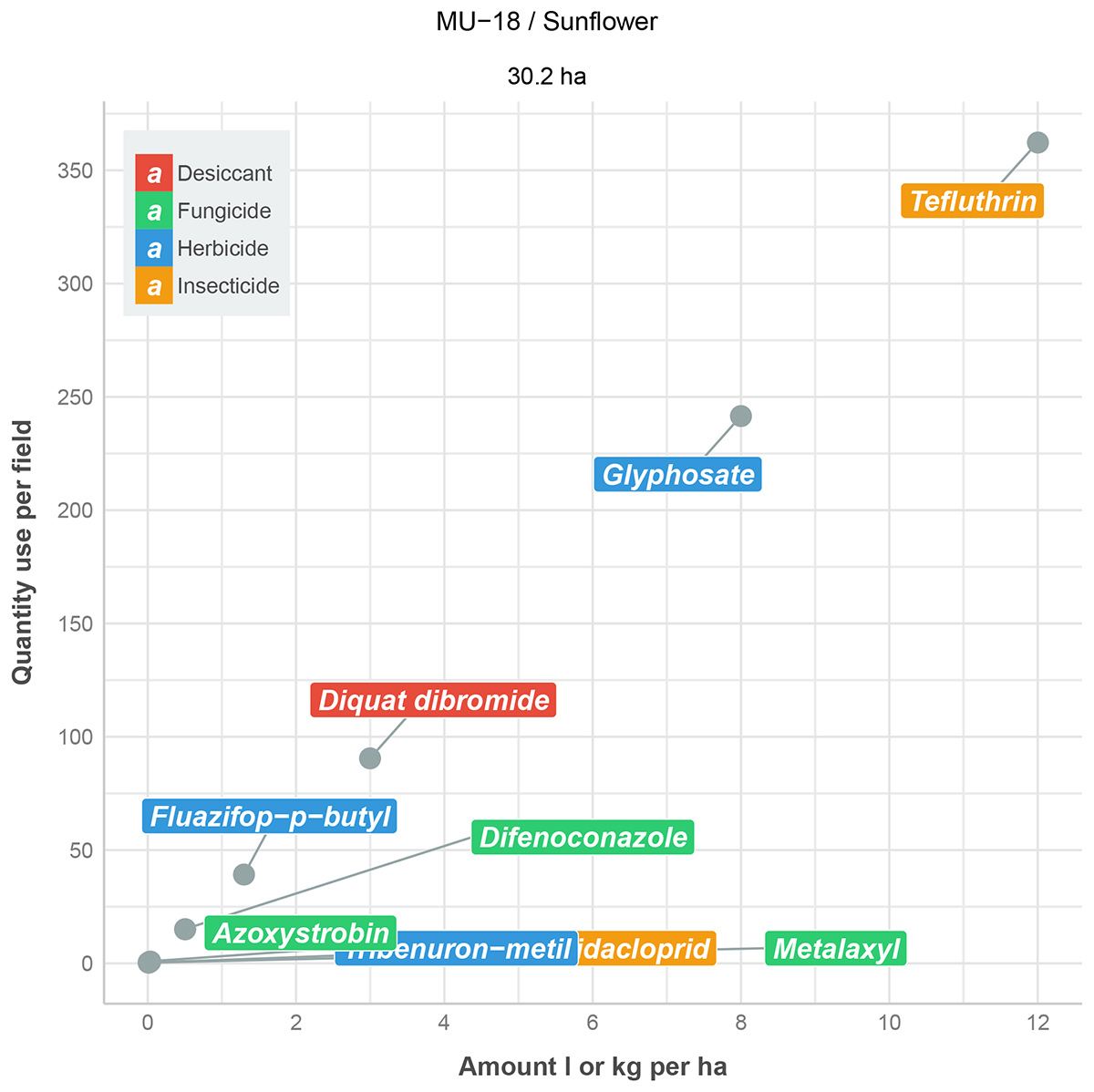
Taking these numbers into consideration, and applying the scenario over our entire 658 hectares of land where we grew sunflowers in 2023, we would have – in a conventional farming scenario – in just one year sprayed 16.5 tonnes of synthetic pesticides.
Over the past three years, we therefore saved our, and your, environment from almost 50 tonnes of synthetic pesticide inputs. Now, that’s something!
Instead, this field only undertook 3 mechanical weed controls during vegetation.
We looked at our 33.8 ha field of wheat (MU-77) and imagined what we would have been doing if we farmed in a conventional way. In this case, on average, we would have used 8 different active ingredients in pesticides, and an incredible amount of 258 kilograms on just one field, making it 7.6 l/kg per hectare.
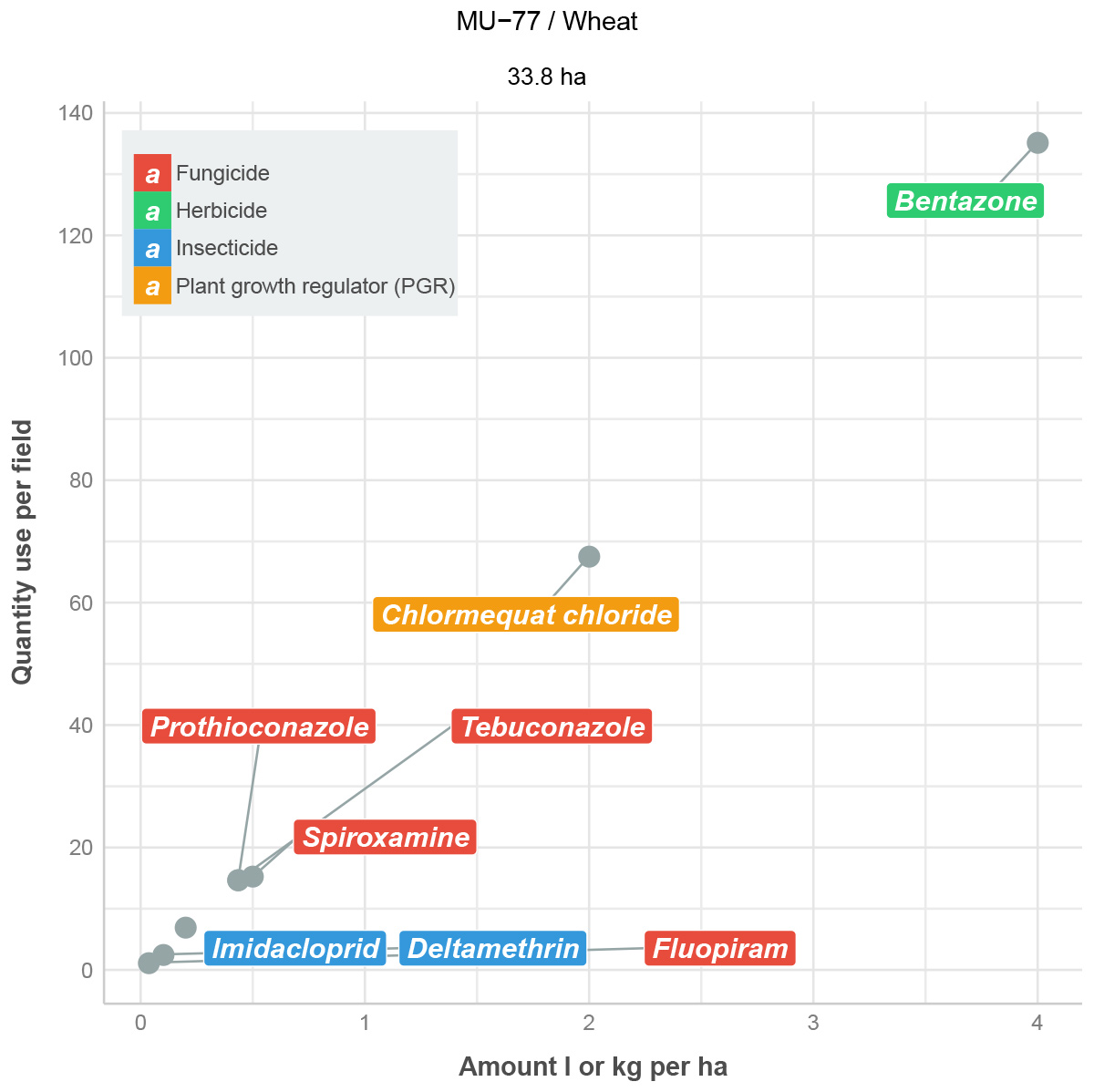
Taking these numbers into consideration, and applying the scenario over our entire 542 hectares of land where we grew wheat in 2023, we would have – in a conventional farming scenario – in just one year sprayed 4,2 tonnes of synthetic pesticides.
Over the past three years, we therefore saved our environment from almost 13 tonnes of synthetic pesticide inputs.
In this field we had one mechanical weed control during vegetation, and one application of biopesticide during wheat flowering stage with the active ingredient of Bacillus subtilis.
If we had opted for conventional production on our MU-15 field of 32 hectares, on average, we would have used 7 different active ingredients in pesticides, and an incredible amount of 310 liters or kilograms on just one field, or 9.7l/kg per hectare.
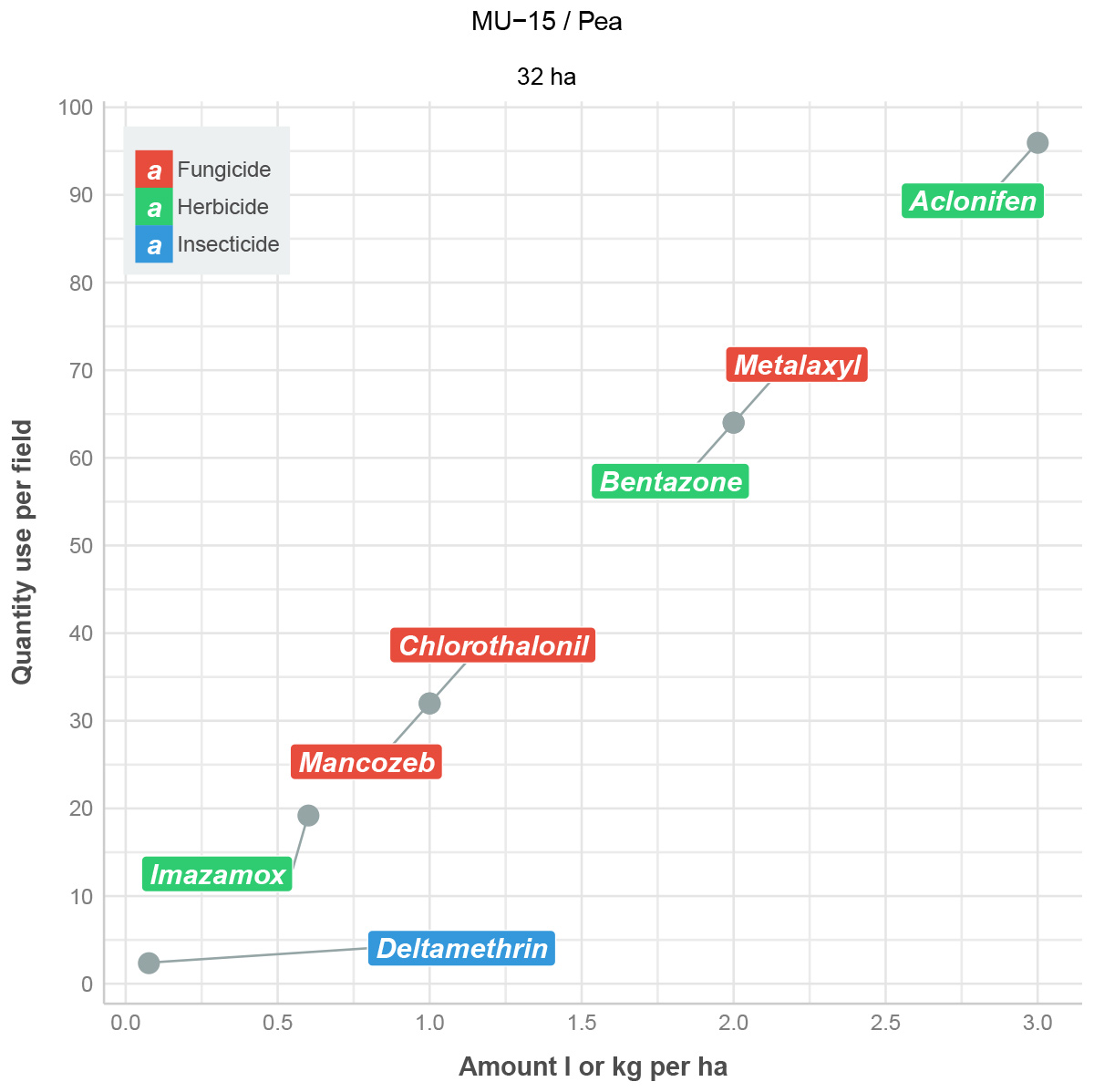
Taking these numbers into consideration, and applying the scenario over our entire 82 hectares of land where we grew wheat in 2023, we would have – in a conventional farming scenario – in just one year sprayed 0,8 tonnes of synthetic pesticides.
Over the past three years, we therefore saved our environment from 2,4 tonnes, approximately of synthetic pesticide inputs.
We didn’t have to do anything in this field – no mechanical control or other interventions were needed.
If we look at the above examples, and expand the calculations to cover a total of our 3.700 hectares of LoginEKO of land, it becomes pretty scary to think about the amount of synthetic material that would have had to be used.
Fortunately, we are involved in sustainable agriculture. Our agronomists constantly search for alternative methods to keep plants healthy and strong without using synthetic agents. And we share all of this with the world for free.
Instead of herbicides for weed control, we go for the mechanical option. This means that we use different tools and techniques to remove, damage, or inhibit the growth of weeds. In this way, we make sure that no chemical residues get or are deposited in our precious soil and crops.
Our agronomists use a combination of sustainable methods, with particular attention paid to timing of operations, to protect our crops, which they call integral weed control.
This sustainable farming approach encompasses:
Mechanical weed control at the LoginEKO farm
To control plant diseases and pests, and preserve crop yield and quality, we sometimes have to rely on the use of biopesticides. They are safe for the environment and non-target organisms, including humans. Biopesticides also have reduced persistence in the environment when compared to synthetic pesticides. As such, they have become the centerpiece in integrated pest management in organic agricultural production.
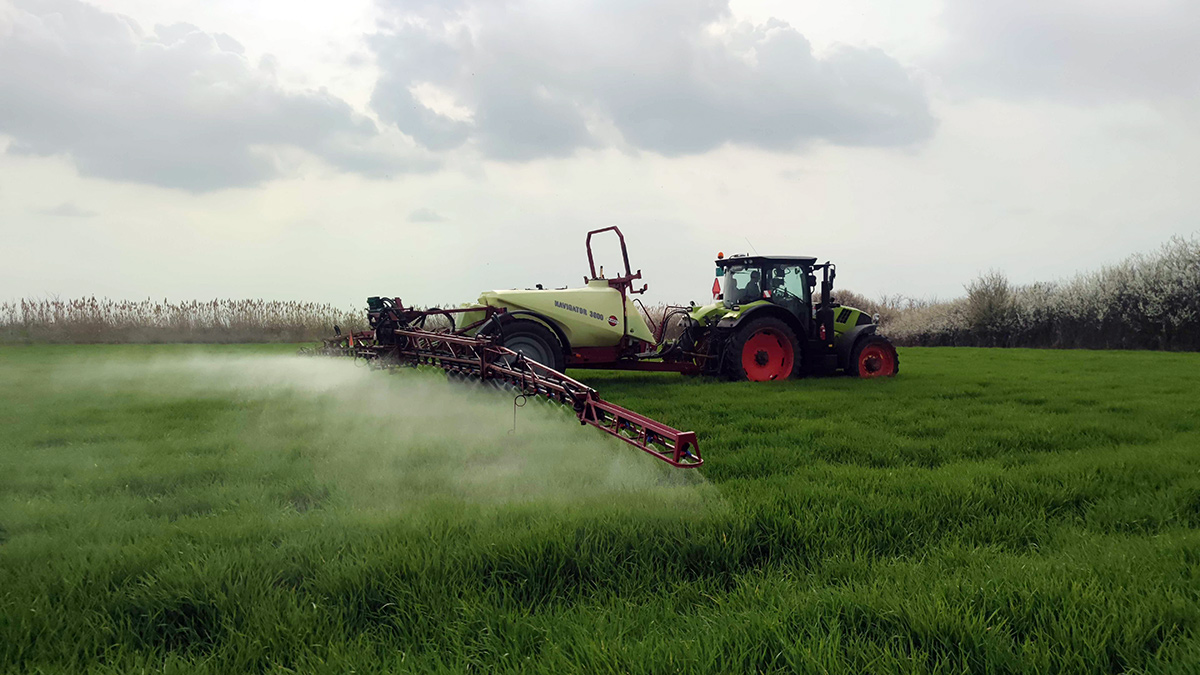
The key difference with conventional pesticides is that active ingredients of biopesticides are not synthetic, but are based on microorganisms (bacteria, viruses, fungi, and nematodes), plant extracts, essential oils, and semiochemicals (pheromones).
The trick is to choose your biopesticide wisely. This means that you should have a comprehensive understanding of the specific pathogen, insect, crop, or environmental problem and the characteristics of the biopesticide you wish to use before you decide to apply it on your field.
Here’s what we have learned so far.
Over the past years, we opted for the use of various different types of biopesticides to either protect or save our crops at the field production level. At every instance, we systematically scouted crops before and after application of the biopesticide to understand how effective the treatment was.
We treated our chickpeas with two different biopesticides against ascochyta blight (Ascochyta rabiei) disease, with low and medium effectiveness. The cotton bollworm (Helicoverpa armigera) also severely damages pods of chickpea plants so we tested another couple of biopesticides, both with good effectiveness against this chickpea specific pest.
Our peas were also subject to diseases and pests, such as downy mildew (Peronospora pisi) and pea aphid (Acyrthosiphon pisum). There, we tested two biopesticides with different active ingredients, both proven to have low effectiveness. For insect control, we used three different preparations, two of which had moderate effect, and one had none. We also used a biopesticide on our borlotti beans attacked by the pea leaf weevil (Sitona lineatus), but with moderate effectiveness.
We treated a barley net blotch (Pyrenophora teres) with two different biopesticides relying on various strains of Bacillus subtilis, both with “Good” effectiveness.
As for treatments used on our oats and wheat, they proved to have no effect on the diseases that attacked them (powdery mildew in oats and leaf rust in wheat).
| Active ingredient | Pest/Disease | Crop | Effectiveness | Dosages per ha |
|---|---|---|---|---|
| Bacillus subtilis | Ascochyta rabiei | Chickpea | Low | 3l |
| Melaleuca alternifolia | Ascochyta rabiei | Chickpea | Moderate | 1l |
| Sulfur + Spinosad | Helicoverpa armigera | Chickpea | Good | 1,5 kg + 0.4l |
| Bacillus thuringiensis subsp. kurstaki | Helicoverpa armigera | Chickpea | Good | 1kg |
| Tribasic copper sulfate (345g/l) | Peronospora pisi | Pea | Low | 2l |
| Copper oxide (750g/l) | Peronospora pisi | Pea | Low | 1kg |
| Spinosad (240g/l) | Acyrthosiphon pisum | Pea | Moderate | 0.3l |
| Spinosad (240g/l) | Lema Melanopus | Wheat/Oats | Good | 0.3l |
| Spinosad (240g/l) | Phyllotreta | Rapeseed/Fodder kale | No effect | 0.3 – 0.6l |
| Azadirachtin | Lema Melanopus | Wheat/Oats | Moderate | 0.3l |
| Pyrethrins (50g/l) | Acyrthosiphon pisum | Pea | Moderate | 0.6l |
| Sulfur (800g/l) | Acyrthosiphon pisum | Pea | No effect | 2l |
| Spinosad (240g/l) | Sitona lineatus | Borlotti bean | Moderate | 0.4l |
| Sulfur (800g/l) | Blumeria graminis f.sp. avenae | Oat | No effect | 2l + 3l |
| Bacillus subtilis strain Z3 | Puccinia recondita | Wheat | No effect | 5l |
| Bacillus subtilis B-04 | Pyrenophora teres | Barely | Good | 2l |
| Bacillus subtilis strain Z3 | Pyrenophora teres | Barely | Good | 5l |
| Potassium hydrogen carbonate (800g/kg) | In progress | |||
| Paraffin oil | In progress | |||
| Azadirachtin A | In progress | |||
| 22% free amino acids, 3% total N, 3% organic N, 40% S | In progress | |||
| N total 0.18%, N organic 0.17% | In progress | |||
| Mn 3% + Zn 1% | In progress |
At the moment, we are running additional field trials to test biopesticides with various active ingredients, and will share results as soon as result analysis becomes available at the end of autumn.
And we are collecting pests and disease information in our Atlas of Diseases and Pests.
Have we kept your attention through the article? Hopefully so.
Because, yes – we know that what’s generally considered a plant protection plan is bad for the environment and human health.
And yes – we know that it’s possible to protect our yields with non-chemical interventions, such as integrated weed control, crop rotation and biopesticides. And while some of these sustainable practices are indeed still to be tested and studied over a longer period of time, including through our multi-year crop rotations, not making a transition towards them should not be an option anymore.
So, if you didn’t know. Now you know.
Sources:
Njamito is now Fairtrade certified for cocoa and vanilla! Here’s what that means for farmers, the planet, and the values behind our meal-in-a-bottle.
Read articleIdealism met reality as we launched our meal-in-a-bottle, Njamito. After 100.000 bottles sold, here’s what we learned about organic food and market adaptation.
Read articleWith organic seeds in short supply, we launched our own organic seed production journey to secure sustainable farming practices.
Read article